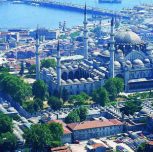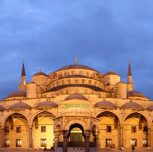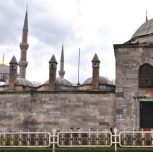Christianity was formed as an organized religion, and was accepted as Rome’s official religion during the reign of Roman Empire Constantine the Great (306-337). During this period, several councils were held to establish the generally accepted rules.
An ecumenical (worldwide) council is a conference held by theological dignitaries and experts to discuss and settle the doctrine and practice of the Roman Church. The first seven Ecumenical Councils are very important, as the decrees of those councils are all recognized by both the eastern and western Roman churches.
1. The First Ecumenical Council, held in Nicaea in 325.
This council is also called the First Council of Nicaea (today, Iznik in Turkey).
In this council, the Christian doctrine was unified, and the beliefs for the whole of Christendom were defined to provide unity. They agreed on the idea of the divinity of Christ, and Christ as a messenger from God (The Father).
They also agreed when to celebrate Easter, the most important feast of the religious calendar.
At the First Council of Nicaea, Constantine, who was present in the meeting, had established Christianity as Rome’s official religion.
2. The Second Ecumenical Council, held in Constantinople in 381.
Also known as the First Council of Constantinople, it was convened in the church of Hagia Irene during the reign of Theodosius I (379-392).
Regarding the teaching of the Holy Spirit, the Council affirmed him to be God "even as the Father and Son are God: who proceeds from the Father, who with the Father and the Son together is worshipped and together glorified."
3. The Third Ecumenical Council, held in Ephesus in 431.
Also known as the Council of Ephesus, it was held in Ephesus, (today, Efes in Turkey) during the reign of Emperor Theodosius II (408-450).
It was decided that the Virgin Mary is the Theotokos (Mother of God), because she gave birth not to a man but to God.
4. The Fourth Ecumenical Council, held in Chalcedon between October 8 and November 1, 451.
It is also called the Council of Chalcedon, and was convened in Chalcedon (today, Kadıköy in Istanbul) by Emperor Marcian (450-457). The term “Chalcedonian Christianity” represents the decrees of this council in the Christian world.
The Council of Chalcedon, held to discuss the nature of Christ, declared that Christ has two natures, both perfect human and perfect divine, unified in one person. This was against the belief of the Monophysites, as they believed in the full union of God and man in a single nature in the person of Christ.
In this council, five patriarchates, each ruled by a patriarch, were established in the Christian world: Rome, Constantinople, Alexandria, Antioch and Jerusalem. In Rome, the patriarch later changed his title to pope. It was also declared that Constantinople was the premier Christian city of the Eastern Empire, which angered patriarchates of Antioch and Alexandria.
5. The Fifth Ecumenical Council, held in Constantinople in 553.
Also known as the Second Council of Constantinople, it took place in Constantinople during the reign of Justinian I (527-565).
The council discussed more in detail the two natures of Christ, and how they formed a single Person.
6. The Sixth Ecumenical Council, held in Constantinople between 680 and 681.
It was also called the Third Council of Constantinople, which was held during the reign of Constantine IV (668-685).
The council condemned the monothelitism (“one will”) of Heraclius (610-641), meaning Christ had two natures (divine and human), but only one will (he acted as God only). His divine nature made all the decisions and his human nature only carried them out.
The council believed that the monothelitism diminished the fullness of Christ’s humanity. Therefore, they accepted the Dyothelitism, meaning human and divine natures of Christ that had both their own wills and operations (two natures and two wills).
The Quinisext Council, held in Constantinople in 692.
This council, also called the Council in Trullo, was convened during the reign of Justinian II (685-695). The Fifth and Sixth Ecumenical Councils had provided no disciplinary canons (rules), but the world had changed since the Fourth Ecumenical Council in 451.
The council consisting of the bishops from the eastern empire focused on reorganization and preservation of the church hierarchy of the empire. However, the council decision about the practice within the empire raised big objections from Rome. Therefore, the Latin Church in Rome has never accepted the Quinisext Council as ecumenical.
7. The Seventh Ecumenical Council, held in Nicaea in 787.
It is also called the Second Council of Nicaea, and was convened during the reign of Constantine VI (780-797).
The council met to end the Byzantine Iconoclasm (726-787), during which holy images were removed or destroyed for religious or political motives. Iconoclasm was started by imperial edict during the reign of Leo III (717–741). The church of Hagia Irene in Istanbul is now the best example of the Iconoclastic Period. In the Council, it was agreed to restore the use and respect of icons (holy images). It was also decided that every altar should contain a relic.
In this period, the Franks became too important to ignore in the church, but nobody invited them to the council. The northern churchmen played a large role in the separation between Rome and Constantinople in the 11th century.
Photian Schism
As the Roman pope's authority was challenged by the Byzantine Emperor, there were two patriarchs in Constantinople during this schism, lasting from 863 to 867.
Ignatius had been the Patriarch of Constantinople since 847, but he was deported in 858 by Byzantine Emperor Michael III (842-867). In his place, Michael III appointed Photios as the new patriarch.
The second wave of Iconoclasm ended when Michael III came to the throne in 842. Two decades later, Michael III wanted to organize a council in Constantinople in 861 to discuss the iconoclasm with his Roman partners in the west. He contacted Roman Pope Nicholas I, and invited his delegations to Constantinople. Ignatius’s complaint was also included in the list of the matters discussed in the assembly. The council discussed the complaint of Ignatius, and under the pressure of Michael III, ruled in favor of Photios.
Surprised and angry at the conclusions of the council held in Constantinople, Pope Nicolas I gathered his own council in Rome in 863. The council in Rome rejected the decision of the Eastern Church about Photios, and reinstated Ignatius. Because of that, there were two patriarchs (Ignatius and Photios) in Constantinople from 863 to 867.
Emperor Basil I (867-886) deposed Patriarch Photios, and reinstated Ignatius in 867 as the new Patriarch of Constantinople. Ignatius stayed in his position until he died in 877. Upon the death of Ignatius, Photios was reinstated to the position of the Patriarch of Constantinople. He is recognized in the Eastern Orthodox churches as St. Photios the Great.
Two centuries later, during the Great Schism of 1054, the relationship between the Western and the Eastern churches was seriously damaged, and resulted in a separation of both churches.
Francis Dvornik, (1970), “Photian Schism, History and Ledgend” - by Cambridge at the University Press, pp.96-97, 107-108
John Karmiris, (1950), “Schism of Roman Church”, University of Athens, pp.408-420
http://www.britannica.com/EBchecked/topic/115240/Christianity/67442/The-Photian-schism-and-the-great-East-West-schism










